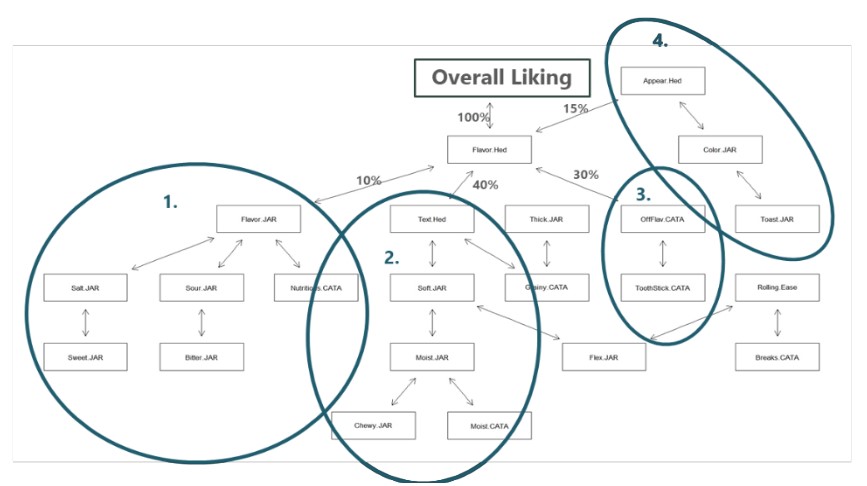Table of Contents
Everything comes with a price, right? And if you’re out shopping, the price tag of your chosen item (and the cost of making it) is proof: the state of the economy is causing prices to be at an all-time high. But does the perceived value line up with the product value? What’s the price you’re willing to pay?

How are consumers coping with high prices and inflation? They’re trading off what they perceive as “value” to justify the price for the product.
- Should they buy your branded product, or go for the generic product?
- Do they buy in bulk, or go for the trial size?
- Do they splurge for the extra features, or stick to the original?
- Should they buy sustainable products with a purpose, or is it within their budget?
The Value Trade Offs
Where can they trade off, and what are they willing to give up? These questions have become increasingly important to your consumers as they are looking for ways to spend their dollars more wisely. As a leader of your brand, you’re looking for ways to highlight the value of your products to win their purchase and repeat purchases.
Knowing about the value trade-off dilemma from a consumer’s perspective, product developers are partnering with product testing and research companies like Curion to dig through and discover product blueprints to re-map value priorities that align with the needs of consumers.
This article dives into how we measure and test for value, and how those insights can closely connect your product and brand to your consumer in areas that matter most.
The Consumer Expectations of Value

When consumers search for a product, they have certain expectations behind the value of what that product can deliver for them. Think Apple Air Pods or hybrid electric vehicles. Consumer expectations about a product or a brand can affect how those consumers perceive their product experience – before they experience it.
Furthermore, these perceptions and expectations can shape our behaviors and product preferences that lead to purchase choices. After all, positive expectations paired with a positive experience from a product can lead to brand loyalty, word-of-mouth advertising, and repeat purchases.
According to an article in Journal of Services Marketing, “Perceived value refers to people’s evaluation after weighing the perceived benefits brought and the cost paid.”
Speaking as a consumer, our expectations should be aligned with the way we perceive the value of the product we’re buying.
The Value Equation
What does a Stanley tumbler, a Squishmallow, and a Tesla have in common? They are all successful products that carry status and a value that consumers are gladly willing to pay for.
In a perfect scenario, a successful product would be the equivalent of the right status, the right value, and the right price. However, no “perfect” scenario likely exists because consumers are often trading up or down to make the purchase.
Simply put, the Value Equation is a trade-off. It’s the balance between perceived benefits and costs. And it’s all in the eye of the consumer. For brands, it becomes important to understand your consumer to know what is meaningful and will deliver the best impact for your target consumer.
So this begs the question: What matters to consumers when it comes to value, and what are they willing to trade off in perceived benefits to result in a purchase?
Factors That Influence Perceived Value
While it can be difficult to decipher, research companies like Curion can uncover the secrets behind what consumers truly value, going deep into psychological triggers.
As Harvard Business Review puts it, “Universal building blocks of value do exist, creating opportunities for companies to improve their performance in current markets or break into new ones.”
HBR uncovered 30 elements of value (“fundamental attributes in their most essential and discrete forms”) that fall into four kinds of needs: functional, emotional, life-changing, and social impact. While they cover inward and outward focused areas in our lives, the more elements a product or service can provide, the greater the brand/product loyalty which leads to higher revenue growth for companies.
Let’s trace this back to the psychologist Abraham Maslow’s Hierarchy of Needs. By identifying and mapping these value elements, the Hierarchy of Needs pyramid switches its focus on people as consumers, and highlights consumer behavior in relation to products.

Through a research study that tested 50 popular U.S. based companies, it was clear that some elements were identified to matter more than others. “Across all the industries we studied, perceived quality affects customer advocacy more than any other element.” With quality in the lead, other elements varied depending on the industry. For example, “sensory appeal” ranked second for food and beverage categories; grocery, discount, and apparel stores called out “variety” for their second highest score; while smartphones scored high in how they delivered value in the form of “reduces effort, saves time, connects, integrates, variety, fun/entertainment, provides access, and organizes.”
Even with quality ranked the highest, there’s still an ongoing debate between the tradeoff value of quality and price, leading consumers to wonder if it’s worth the money they’re spending. In some cases, a lower cost or generic alternative can deliver on the same experience and will draw more buyers if the value of a higher priced branded product isn’t noticed or acknowledged by consumers.
Strategic Testing for Value Perceptions
Curion’s mission is to connect brands to people, and we constantly help brands test their products to find perceived value for people by implementing Choice-Based Modeling through various Evaluative Statistical approaches. These advanced statistics can be built into regular product testing processes in-person and in-location or online like a Central Location Test (CLT) or a Home-Use Test (HUT) study to indicate which attributes are essential to consumer liking and how a product can achieve an even higher product preference.
 One example of this approach is called Bayesian Neural Network Mapping (picture shown on left). Bayesian Neural Network Mapping is a method of using Bayesian inference with neural networks to understand uncertainty in predictions. Instead of giving a single prediction, it provides a range of possible outcomes along with their probabilities, allowing for more informed decision-making. Take, for example, a weather forecast that tells you the most likely outcome, then going beyond by giving you a sense of how certain or uncertain that prediction is.
One example of this approach is called Bayesian Neural Network Mapping (picture shown on left). Bayesian Neural Network Mapping is a method of using Bayesian inference with neural networks to understand uncertainty in predictions. Instead of giving a single prediction, it provides a range of possible outcomes along with their probabilities, allowing for more informed decision-making. Take, for example, a weather forecast that tells you the most likely outcome, then going beyond by giving you a sense of how certain or uncertain that prediction is.
Curion partnered with a luxury automotive company that pioneers product breakthroughs to fit their target consumer lifestyle. Through one of our studies, we tested over 40 features to learn which drove the highest interest in purchasing the client’s luxury outdoor product. Through Choice-Based modeling, a type of Conjoint testing, we were able to measure how a targeted group of consumers and brand users put value on the product and its features to reveal insights that lead to product preferences and purchase intent.
Brand loyalty is also a huge factor that plays into perceived value. When consumer segmentation is implemented into studies we’ve performed, we sifted through and uncovered what is considered valuable to different groups of consumers based on their demographics, lifestyles, interests, and much more. Focusing on certain segments and crossover elements across various segments can allow brands to identify areas of perceived value amongst their core target consumers. In many cases with segmentation, brand personas are generated to understand core segments and their level of brand loyalty.
 KANO (picture shown on right) is another method used to understand and measure the needs of consumers. Using this method, we help brands understand how their consumers are emotionally responding to product features which paves a path to focus on the attributes that matter most. In one study we implemented with a dairy foods client, we conducted a 2-phase process that tested various attributes across the ice cream category, then conducted deeper research that revealed how consumers feel about those attributes being present or absent. Each attribute was defined and grouped as a must-have attribute, expected attribute, and a delighter attribute. Through the lens of their consumer, the client was able to see the perceived value of their product and refocus product development efforts for a bigger impact and repurchase effect.
KANO (picture shown on right) is another method used to understand and measure the needs of consumers. Using this method, we help brands understand how their consumers are emotionally responding to product features which paves a path to focus on the attributes that matter most. In one study we implemented with a dairy foods client, we conducted a 2-phase process that tested various attributes across the ice cream category, then conducted deeper research that revealed how consumers feel about those attributes being present or absent. Each attribute was defined and grouped as a must-have attribute, expected attribute, and a delighter attribute. Through the lens of their consumer, the client was able to see the perceived value of their product and refocus product development efforts for a bigger impact and repurchase effect.
Other methods also exist to uncover value perceptions in quantitative and qualitative research and testing methods. These include PROP studies, Alienation testing, Drivers of Liking, and Curion’s proprietary method called Fuel.
Is Your Product Built For Value?
In the end, the answers come down to each specific consumer value system. Do your consumers value status, functional benefits, brand name, sustainability, or something else entirely? It is crucial for brands and product developers to understand who their consumers are and know what resonates with them.
By conducting the right type of value research led by established, renowned, and well-known research companies like Curion, you and your fellow brand leaders will be reassured that your products are perceived as worth the price.
Let this serve as a future call to action for your brand and products to continually assess and realign your product value proposition with your consumer expectations. Rest assured, we’ve got your back to do the heavy lifting and ensure you that your products are built and designed for value.
Curion specializes in delivering impactful insights to the world’s top CPG companies, helping them develop winning, repeatedly purchased products. Curion’s deep data-driven product insights, sensory expertise, and state-of-the-art consumer centers enable them to uncover responses to critical client objectives. With over five decades of experience in the product testing industry, Curion is dedicated to guiding clients with their proprietary XP Xperience Performance platform, connecting brands to consumers at every step.
An innovator in the industry, Curion recently developed a groundbreaking benchmarking product testing method, the Curion Score™, which has become a trusted and sought after tool within the industry. As one of the largest product and consumer insights companies in the U.S., Curion has built a reputation for excellence and trust among the world’s leading consumer brands. Curion’s commitment to innovation and expertise, coupled with a passion for delivering actionable insights, makes Curion a valuable partner for companies looking to develop and launch successful products.
